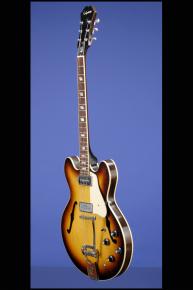An Exceptionally Fine 'Mid-to-Late Sixties' Epiphone Casino
This exceptionally fine mid-to-late sixties 16-inch-wide fully hollow thinbody guitar weighs just 6.30 lbs. and has a nut width of 1 9/16 inches and a standard Gibson scale length of 24 3/4 inches. Laminated maple body with single binding on the top and back, one-piece mahogany neck with a medium profile, and bound rosewood fretboard with 22 jumbo frets and inlaid pearl single-parallelogram position markers (no inlay at the 1st fret, as usual). Long headstock with inlaid pearl "Epiphone" script logo. Three-layer (black/white/black) plastic truss-rod cover with Epiphone stylized "E" logo engraved in white. Individual dual-line Kluson Deluxe tuners with oval metal buttons. Serial number "522008" impressed into the back of the headstock. Two chrome-covered P-90 pickups with outputs of 7.71k and 8.43k. Four-layer (white/black/white/black) plastic pickguard with bevelled edge. Four controls (two volume, two tone) plus three-way selector switch for pickup selection, all on lower treble bout. Black plastic ribbed-sided conical-shaped "Witch Hat" knobs. Gibson ABR-1 Tune-O-Matic retainer bridge with metal saddles and Epiphone Tremotone Vibrola with rosewood insert inlaid with silver and black Epiphone stylized "E" logo. Original factory order number (FON) "10779" stamped in black inside the body of the guitar. This guitar is in exceptionally fine (9.00) condition, with only a few minuscule belt buckle marks on the back and a few tiny marks on the sides. The only issue that prevents us from giving this superb thirty-eight-year-old "John Lennon" guitar a near mint rating is that there is a tiny bit of wear on the lower edge of the headstock and the silver and black Epiphone stylized "E" logo on the pickguard has come away leaving just the shadow of the "E." Housed in an early seventies Gibson black hardshell case with maroon plush lining (9.00). The original cost in 1968 was $425.00 plus another staggering $81.00 for the case!
"The Casino, introduced in 1961, is the equivalent of the Gibson ES-330 -- a fully hollow thinbody guitar with one or two P-90 pickups. The dot inlay gave way to parallelograms by 1963. The Epiphone vibrato, featuring a string-anchor bar of varying diameter to compensate for different string gauges, was never used on a Gibson-brand model" (George Gruhn and Walter Carter, Electric Guitars and Basses: A Photographic History, p. 220).
"Popularity of the [Epiphone] thinlines increased in the 1960s when first Paul McCartney acquired a Casino for Beatle studio work, followed by John Lennon and George Harrison who each used new Casinos on-stage in the final fab-four concerts of 1966. The group's new Epis were also all over the band's latest Revolver LP, and the Beatle connection has ensured that the Epiphone thinlines in general and the Casino model in particular enjoy a continuing popularity among pop groups who find themselves keen on reactivating a Merseyside-style mix" (Tony Bacon, Electric Guitars: The Illustrated Encyclopedia, p. 55).
Introduced in 1961, this was Epiphone's $335.00 version of the highly popular Gibson ES-330. The Casino was discontinued in 1970. B.B. King, Eric Clapton, and Jimmy Hendrix (while playing with the Isley Brothers) were all playing Epiphone Casinos. Near the end of 1964, Epiphone scored an unexpected coup when the Beatles bought three Casinos -- one each for George Harrison, John Lennon, and Paul McCartney. All three Casinos were Sunburst, and George's had a Bigsby vibrola tailpiece. McCartney put his on record almost immediately, playing the guitar fills on the group's 1965 hit "Ticket to Ride" on his Casino. Fans around the world saw the Casinos on the Beatles's world tour of 1966. The group used them on various recordings and promotional films.
Translate:









